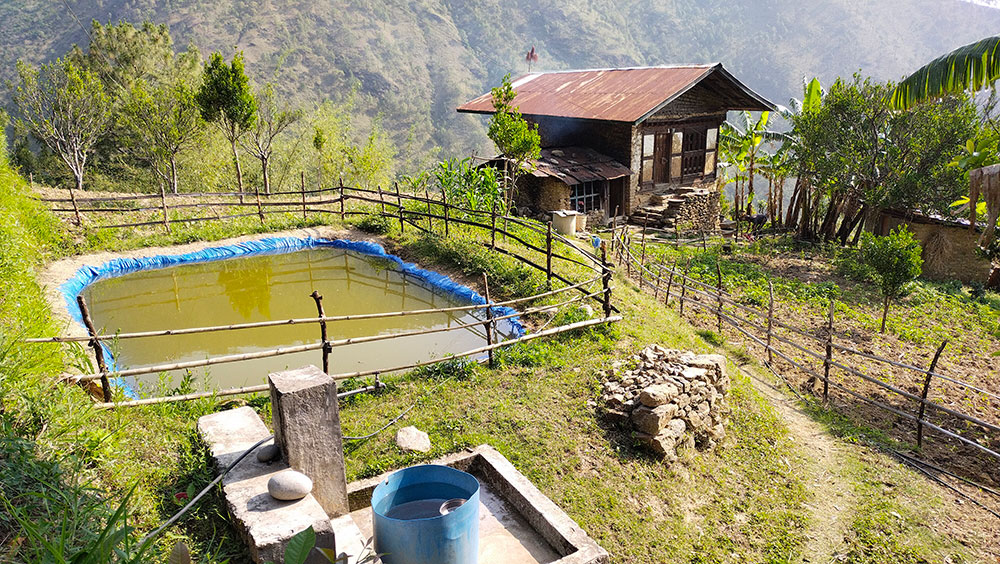
Water harvesting ponds solve water shortage in Lephu village
Three years ago, Phurpa Lhamo, a farmer from Lephu village in Yangnyer, Trashigang, had to fetch water in buckets to irrigate her fields. On most days, she had to wake up early in the morning for the gruelling task.
Today, she can enjoy the luxury of early morning slumber, thanks to a climate-smart technology called the low-cost plastic-lined water harvesting pond.
This water harvesting technology stores runoff or rainwater in a pond for use during the dry season for agriculture and household purposes. This simple technology has come as a boon for the village.
The water harvesting technology was introduced in Yangnyer in 2021 with support from the Commercial Agriculture and Resilient Livelihoods Enhancement Programme (CARLEP).
Phurpa Lhamo built a pond above her house. She said getting enough water for crops is one of the main problems facing the village.
“This technology has greatly helped me irrigate my vegetable garden,” she said. “Water is no longer an issue.”
Before the introduction of the tarpaulin pond technology, people used groundwater for vegetable gardening. Not everyone received enough.
Like other farmers, 61-year-old Lamoi Yueduen pumps water from her pond into her fields. The pond is kept open to collect rainwater. When not in use, she connects it to the drinking water line.
Lhamo Yueduen said that earlier, the farmers from her village could not grow anything due to the water shortage. They lacked even adequate drinking water.
“It was a serious issue. This technology is convenient and helps improve our livelihood. I am grateful for it,” she said.
Farmers dug ponds based on the specifications the agriculture ministry provided. Based on the size of the pond, a tarpaulin sheet is laid inside the pond to stop water from seeping into the ground.
Farmers stored rainwater, water from perennial sources, or water from drinking pipelines. The water from the pond was then pumped into the fields or drained through a pipe connected to it. Depending on size, a water harvesting pond can store 17 to 40 cubic litres of water.
Currently, 13 farmers in Yangnyer use this water harvesting technology.
Tempa Dorji, 54, from Lephu said water scarcity in the village was particularly dire during winter.
“Thanks to the water harvesting ponds, we can now grow winter vegetables,” he said. “Using this technology, most farmers can now undertake large-scale vegetable farming.”
He said some farmers make an annual income of Nu 50,000 to Nu 100,000.
Tshering Lhamo, another farmer, pumps water from the spring near her house into her pond. In summer, she collects rainwater in it.
She said that she could start vegetable farming three times in a year after the construction of the water harvesting pond. “Earlier, we could grow vegetables only enough to meet our domestic needs,” she said. “Beyond that, it was difficult with the shortage of water.”
Today, Tshering earns between Nu 10,000 and Nu 20,000 a month from selling vegetables, such as beans, asparagus, and chillies.
The agriculture extension supervisor of Yangnyer gewog, Tashi Wangmo, said the water harvesting technology allows farmers to collect water which can be used when there is water scarcity or during a prolonged drought.
Tashi Wangmo said the water cycle is disrupted by climate change, causing erratic rainfall. She said water harvesting ponds, she said, is one way of building resilience to climate change.
The technology was introduced in Lephu village because it has an active farming community that is engaged particularly in vegetable and citrus production, said the agriculture extension supervisor.
Tashi Wangmo explained that the water harvesting technology is successful due to its low cost and implementation at the household level.
“The vegetable production success that Lephu farmers experience today is due to water harvesting technology,” she said. “More farmers are interested in investing in the technology.”












